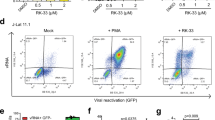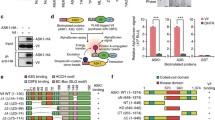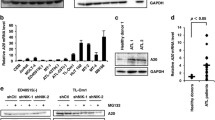Abstract
Fas-associated protein with death domain (FADD) is a key adaptor molecule transmitting the death signal mediated by death receptors, and it is also required for T cell proliferation. A recent study indicated that FADD is able to affect HIV-1 production, but the mechanism is not known. Using the susceptible Jurkat cell line and peripheral blood mononuclear cells, we studied the effects of FADD on HIV-1 production. TaqMan RT-PCR was used to quantify HIV-1 viral RNA copies, and Western blot analysis was used to detect protein expression. FADD knockdown decreased HIV-1 replication and inactivated caspase-3 activity in the cells and blocked CD4 translocation to the lipid rafts of the plasma membrane. Reduced expression of FADD suppressed TCR signaling through downregulation of TCR, CD3, and Zap-70 in response to HIV-1 infection and blocked the trafficking of TCR, CD3, CD28, and Zap-70 to lipid rafts, leading to reduced activation of NF-κB and NFAT, which are required for HIV-1 replication. FADD knockdown diminished caspase-8 migration to lipid rafts and its expression in response to HIV-1 infection. These results indicate that FADD, as a host pro-apoptotic protein, plays important roles in regulating HIV-1 replication and production in several ways, and apoptotic pathway inhibition is able to decrease HIV-1 replication and production.







Similar content being viewed by others
References
Ganser-Pornillos BK, Yeager M, Pornillos O (2012) Assembly and architecture of HIV. Adv Exp Med Biol 726:441–465
Moss JA (2013) HIV/AIDS review. Radiol Technol 84:247–267
Cummins NW, Badley AD (2010) Mechanisms of HIV-associated lymphocyte apoptosis: 2010. Cell Death Dis 1:e99
Silvestris F, Cafforio P, Frassanito MA, Tucci M, Romito A, Nagata S, Dammacco F (1996) Overexpression of Fas antigen on T cells in advanced HIV-1 infection: differential ligation constantly induces apoptosis. AIDS 10:131–141
Sloand EM, Maciejewski JP, Sato T, Bruny J, Kumar P, Kim S, Weichold FF, Young NS (1998) The role of interleukin-converting enzyme in Fas-mediated apoptosis in HIV-1 infection. J Clin Invest 101:195–201
Balestrieri E, Grelli S, Matteucci C, Minutolo A, d’Ettorre G, Di Sora F, Montella F, Vullo V, Vella S, Favalli C, Macchi B, Mastino A (2007) Apoptosis-associated gene expression in HIV-infected patients in response to successful antiretroviral therapy. J Med Virol 79:111–117
O’Brien MA (2008) Apoptosis: a review of pro-apoptotic and anti-apoptotic pathways and dysregulation in disease. J Vet Emerg Crit Care 18:572–585
Walsh CM, Wen BG, Chinnaiyan AM, O’Rourke K, Dixit VM, Hedrick SM (1998) A role for FADD in T cell activation and development. Immunity 8:439–449
Newton K, Harris AW, Strasser A (2000) FADD/MORT1 regulates the pre-TCR check point and can function as a tumour suppressor. EMBO J 19:931–941
Kabra NH, Kang C, Hsing LC, Zhang J, Winoto A (2001) T cell-specific FADD-deficient mice: FADD is required for early T cell development. Proc Natl Acad Sci USA 98:6307–6312
Alappat EC, Feig C, Boyerinas B, Volkland J, Samuels M, Murmann AE, Thorburn A, Kidd VJ, Slaughter CA, Osborn SL, Winoto A, Tang W, Peter ME (2005) Phosphorylation of FADD at serine 194 by CKIα regulates its nonapoptotic activities. Mol Cell 19:321–332
Schinske KA, Nyati S, Khan AP, Williams TM, Johnson TD, Ross BD, Tomás RP, Rehemtulla A (2011) A novel kinase inhibitor of FADD phosphorylation chemosensitizes through the inhibition of NF-κB. Mo. Cancer Ther 10:1807–1817
Chen G, Bhojani, Heaford AC, Chang DC, Laxman B, Thomas DG, Griffin LB, Yu J, Coppola JM, Lin L, Adams D, Orringer MB, Ross BD, Beer DG, Rehemtulla A (2005) Phosphorylated FADD induces NF-κB, perturbs cell cycle, and is associated with poor outcome in lung adenocarcinomas. Proc Natl Acad Sci USA 102:12507–12512
Cheng J, Montecalvo A, Kane LP (2011) Regulation of NF-κB induction by TCR/CD28. Immuno Res 50:113–117
Luo C, Wang K, Liu D, Li Y, Zhao Q (2008) The functional roles of lipid rafts in T cell activation, immune diseases and HIV infection and prevention. Cell Mol Immunol 5:1–7
Wang X, Viswanath R, Zhao J, Hewlett I (2011) Molecules from apoptotic pathways modulate HIV-1 replication in Jurkat cells. Biochem Biophys Res Commun 414:20–24
Gupta P, Singhal PK, Rajendrakumar P, Padwad Y, Tendulkar AV, Kalyanaraman VS, Schmidt RE, Srinivasan A, Mahalingam S (2011) Mechanism of host cell MAPK/ERK-2 incorporation into lentivirus particles: characterization of the interaction between MAPK/ERK-2 and proline-rich-domain containing capsid region of structural protein Gag. J Mol Biol 410:681–697
Gong J, Shen XH, Chen C, Qiu H, Yang RG (2011) Down-regulation of HIV-1 infection by inhibition of the MAPK signaling pathway. Virol Sin 26:114–122
Zhang HS, Sang WW, Ruan Z, Wang YO (2010) Akt/Nox2/NF-κB signaling pathway is involved in Tat-induced HIV-1 long terminal repeat (LTR) transactivation. Chin Med J 123:2440–2445
Farrow MA, Kim EY, Wolinsky SM, Sheehy AM (2011) NFAT and IRF proteins regulate transcription of the anti-HIV gene, APOBEC3G. J Biol Chem 286:2567–2577
Wang X, Viswanath R, Zhao J, Tang S, Hewlett I (2010) Changes in the level of apoptosis-related proteins in Jurkat cells infected with HIV-1 versus HIV-2. Mol Cell Biochem 337:175–183
Su H, Bidère N, Zheng L, Cubre A, Sakai K, Dale J, Salmena L, Hakem R, Straus S, Lenardo M (2005) Requirement for caspase-8 in NF-kappaB activation by antigen receptor. Science 307:1465–1468
Bren GD, Trushin SA, Whitman J, Shepard B, Badley AD (2009) HIV gp120 induces, NF-kappaB dependent, HIV replication that requires procaspase 8. PLoS ONE 4:e4875
Misra RS, Russell JQ, Koenig A, Hinshaw-Makepeace JA, Wen R, Wang D, Huo H, Littman DR, Ferch U, Ruland J, Thome M, Budd RC (2007) Caspase-8 and c-FLIPL associate in lipid rafts with NF-kappaB adaptors during T cell activation. J Biol Chem 282:19365–19374
Pietiäinen VM, Marjomäki V, Heino J, Hyypiä T (2005) Viral entry, lipid rafts and caveosomes. Ann Med 37:394–403
Hiscott J, Kwon H, Genin P (2001) Hostile takeovers: viral appropriation of the NF-kB pathway. J Clin Invest 107:143–151
Marwali MR, MacLeod MA, Muzia DN, Takei F (2004) Lipid rafts mediate association of LFA-1 and CD3 and formation of the immunological synapse of CTL. J Immunol 173:2960–2967
Huang SC, Tsai HF, Tzeng HT, Liao HJ, Hsu PN (2011) Lipid raft assembly and Lck recruitment in TRAIL costimulation mediates NF-κB activation and T cell proliferation. J Immunol 186:931–939
Hashimoto-Tane A, Yokosuka T, Ishihara C, Sakuma M, Kobayashi W, Saito T (2010) T-cell receptor microclusters critical for T-cell activation are formed independently of lipid raft clustering. Mol Cell Biol 30:3421–3429
Szabo M, Czompoly T, Kvell K, Talaber G, Bartis D, Nemeth P, Berki T, Boldizsar F (2012) Fine-tuning of proximal TCR signaling by ZAP-70 tyrosine residues in Jurkat cells. Int Immunol 24:79–87
Henne WM, Buchkovich NJ, Emr SD (2011) The ESCRT pathway. Dev Cell 21:77–91
Balasubramaniam M, Freed EO (2011) New insights into HIV assembly and trafficking. Physiology (Bethesda) 26:236–251
Weiss ER, Göttlinger H (2011) The role of cellular factors in promoting HIV budding. J Mol Biol 410:525–533
Chan D, Kim P (1998) HIV entry and its inhibition. Cell 93:681–684
Wyatt R, Sodroski J (1998) The HIV-1 envelope glycoproteins: fusogens, antigens, and immunogens. Science 280:1884–1888
Sebban H, Yamaoka S, Courtois G (2006) Posttranslational modifications of NEMO and its partners in NF-kappaB signaling. Trends Cell Biol 16:569–577
Uren AG, O’Rourke K, Aravind LA, Pisabarro MT, Seshagiri S, Koonin EV, Dixit VM (2000) Identification of paracaspases and metacaspases: two ancient families of caspase-like proteins, one of which plays a key role in MALT lymphoma. Mol Cell 6:961–967
Bidere N, Snow AL, Sakai K, Zheng L, Lenardo MJ (2006) Caspase-8 regulation by direct interaction with TRAF6 in T cell receptor induced NF-kappaB activation. Curr Biol 16:1666–1671
Acknowledgments
The authors wish to acknowledge Dr. Mingjie Zhang, Dr Cheng Sun, and Ewan Plant for critical review of this manuscript. The findings and conclusions in this article have not been formally disseminated by the Food and Drug Administration and should not be construed to represent any Agency determination or policy.
Author information
Authors and Affiliations
Corresponding authors
Additional information
Xue Wang and Jiying Tan contributed equally to this work.
Electronic supplementary material
Below is the link to the electronic supplementary material.
11010_2014_2058_MOESM1_ESM.ppt
A. No significant effect of Adenovirus containing LacZ on HIV-1 production in Jurkat cells. To investigate whether adenovirus containing LacZ affects HIV-1 production, Jurkat cells were infected with HIV-1 (MN) for 2 hours, and then incubated with/without adenovirus inserted a gene, LacZ, and cultured for 3 days. One hundred forty µl of the culture supernatants containing HIV-1 particles were used to isolate viral RNA. Five µl in 50 µl of the RNA was used as template to perform real-time PCR. Statistically, as shown in Fig. A, there was no significant difference of HIV-1 production between the treatments of HIV-1 infection and HIV-1 + adenovirus containing LacZ. B. Lipid rafts and caveolae are plasma membrane domains that are enriched in cholesterol and sphingolipid. Both lipid rafts and caveolae are docking sites for specific proteins involved in signal transduction. Caveolae are a specialised form of lipid raft, defined by the presence of a specific cellular protein marker, caveolin. The term ‘lipid rafts’ reflects the ability of these microdomains to serve as relay stations in intracellular signaling pathways or as vehicles for the transport of selected lipid membrane molecules.Jurkat cells infected HIV-1 for 2 hours, and then incubated with adenovirus inserted a gene LacZ or anti-sense FADD for 3 days. Total cell lysates were loaded on the discontinuous sucrose gradients for 18 h (39,000 rpm, SW 41 rotor). Twelve fractions of each were obtained and subjected to Western blot analysis for Flotillin-1. Flotillins are lipid raft components, and belongs to stomatin protein family, whose members are characterized by the presence of a hydrophobic N-terminal region that is predicted to form a single, outside to inside, transmembrane domain. (PPT 67 kb)
Rights and permissions
About this article
Cite this article
Wang, X., Tan, J., Zhao, J. et al. Some findings of FADD knockdown in inhibition of HIV-1 replication in Jurkat cells and PBMCs. Mol Cell Biochem 393, 181–190 (2014). https://doi.org/10.1007/s11010-014-2058-7
Received:
Accepted:
Published:
Issue Date:
DOI: https://doi.org/10.1007/s11010-014-2058-7




